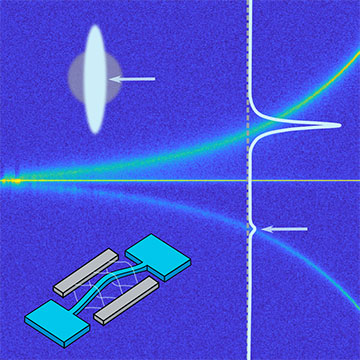
Researchers have identified two sidebands (green and blue) in the spectrum of a tiny vibrating “string” of silicon nitride (lower left) subject to a periodic driving force, showing that the different intensities of those sidebands correspond to the strength of squeezing (upper left). [Image: Weig Group, University of Konstanz]
In everything from gravitational-wave observatories to state-of-the-art biosensors, scientists use squeezed states to reduce the uncertainty in sensitive measurements. Now, researchers in Germany and the U.S. have shown a new way of detecting squeezed states in one hard-to-measure system—a minute, weakly-damped mechanical resonator driven out of equilibrium (Phys. Rev. X, doi: 10.1103/PhysRevX.10.021066).
Exploiting squeezed states
Squeezed states have been much studied in quantum optics. They arise from a trade-off in the uncertainties of a light field’s phase and amplitude “quadratures.” Although Heisenberg’s principle stipulates a minimum value for the product of these uncertainties—ħ/2—it doesn’t prevent one from being reduced at the expense of the other. If those uncertainties are represented as the two orthogonal axes of an ellipse, that ellipse is “squeezed” along the axis of interest.
This idea has been exploited, for example, in the world’s leading gravitational-wave detectors. There, the phase of a laser beam used to reveal the presence of a passing wave can have its otherwise minimum uncertainty reduced in order to render the detector more sensitive at high frequencies.
Nanostring vibrations
However, as Eva Weig, Jana Huber and colleagues at the University of Konstanz, Germany, and Michigan State University, USA, point out in their paper, squeezed states are not confined to the quantum world. The system they study is a tiny but nevertheless classical system—a 100-nanometer thick strip, or “string,” of silicon nitride pinned at each end and made to vibrate by driving it with a radiofrequency voltage. This string has a very high quality factor—at room temperature it vibrates more than 300,000 times before finally coming to rest.
Tiny resonators like this can be used to sense mass at the level of single molecules or to detect electric and magnetic forces of just 10−19 N/Hz1/2. However, unless the device is cooled to extremely low temperatures its measurements are degraded by thermal vibrations. The laws of thermodynamics dictate that this noise is equally split among the vibration quadratures, which correspond to the resonator’s maximum displacement and momentum.
Weig and co-workers have shown that they can redistribute this noise by subjecting the resonator to a moderately large external force at the system’s resonant frequency. As they explain, this periodic driving force breaks time-translation symmetry. Normally, momentum and displacement exchange maxima every quarter of a period—the string being straight when its center is moving quickest, and most distorted when the center is at rest. But the driving force disrupts that symmetry, and with it the equality of noise associated with the two variables.
Turning to spectral evidence
The Konstanz group did not record the thermal vibrations directly—something usually done with a homodyne detector—since the effect of frequency fluctuations in a weakly-damped resonator makes it difficult to resolve the two quadratures. So the researchers turned to an alternative measure of the underlying asymmetry—the string’s spectral output.
Using a microwave-cavity assisted detection scheme to probe the string’s absorption spectrum, the researchers identified a peak at the central resonant frequency as well as two sidebands. As predicted in a theoretical model developed by Michigan State’s Mark Dykman, alongside Gianluca Rastelli and Wolfgang Belzig at Kostanz, these sidebands are positioned symmetrically around the resonance peak. Also in line with the model, the sidebands have different intensities from one another—with the ratio of the intensities reflecting the degree of squeezing.
Weig and colleagues caution that this new measure of squeezing is indirect. But they argue that their approach nevertheless “opens a way to deduce squeezing of thermal fluctuations in strongly under-damped resonators,” where standard homodyne measurements are hard to do.
They say that the results could lead to the development of new types of nanomechanical sensors for measuring force or mass. More broadly, they argue that “there is a lot to be learned about fluctuations in high quality factor vibration systems.” Their next step, they say, is to explore the spectral signatures of squeezing in quantum systems, with the intent of applying their findings “to the broad field of quantum sensing.”
